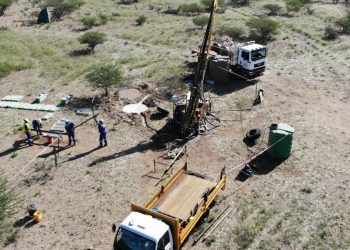
B2Gold Namibia has announced plans to retrench an additional 300 employees at its Otjikoto Mine in 2025, as the company transitions from open-pit to underground mining, following the retrenchment of 190 workers in 2024.
The workforce reductions come as part of the mine’s structural shift aimed at extending its operational lifespan through underground mining and stockpile processing, with open-pit mining activities nearing completion.
“In 2025, we will go down from a permanent headcount of around 700 employees to 400,” said B2Gold Namibia Country Manager, John Roos.
“That means 300 employees will be impacted during 2025 as we complete the retrenchment phase and adjust to the new underground setup.”
Roos explained that the Otjikoto Mine is reaching the end of its open-pit life, with output already on a sharp decline.
He noted that the move to underground mining would significantly reduce the mine’s labour requirements, from a peak workforce of around 890 to just 400.
The company began reducing its workforce in April 2024, with 190 employees having exited by the end of the year.
“By December, we had reached the tail end of our 2024 retrenchment process. The changes are necessary to align with the mine’s operational demands going forward,” Roos said.
Otjikoto Mine General Manager, Eric Barnard, said the process was approached with careful planning to minimise disruptions and ensure fairness.
“To date, we’ve made 179 positions redundant, and we have retrenched 138 people. Out of those, 95 left voluntarily, with only 33 retrenched involuntarily,” Barnard said.
He noted that many of the voluntary exits were employees who had prepared themselves for the shift in operations. “When a position becomes redundant and is vacant, we don’t refill it. Instead, we adapt to working without it, and that role falls away without affecting anyone,” he added.
Barnard also confirmed that mining volumes have steadily declined since January 2024, with further reductions expected as open-pit mining winds down through to the end of 2025.
“The operation is reaching the transition point where underground mining will replace open-pit activities,” he said.
Despite the operational downsizing, B2Gold has continued investing in its Namibian operations. In 2024, the company invested N$324 million (US$17 million) into the Otjikoto Mine, resulting in the production of 198,142 ounces of gold—closely aligning with the midpoint of its revised guidance range of 185,000 to 205,000 ounces.
According to the company, Otjikoto produced 52,452 ounces of gold in the fourth quarter of 2024, supported by steady output from the Wolfshag underground section. During the period, 788,536 tonnes of ore were milled at an average grade of 2.10 grams per tonne, achieving a recovery rate of 98.6%. Gold sales for the quarter amounted to 50,330 ounces.
“For the full year 2024, the Otjikoto Mine produced 198,142 ounces of gold, near the midpoint of its revised guidance range of between 185,000 and 205,000 ounces,” B2Gold said.







